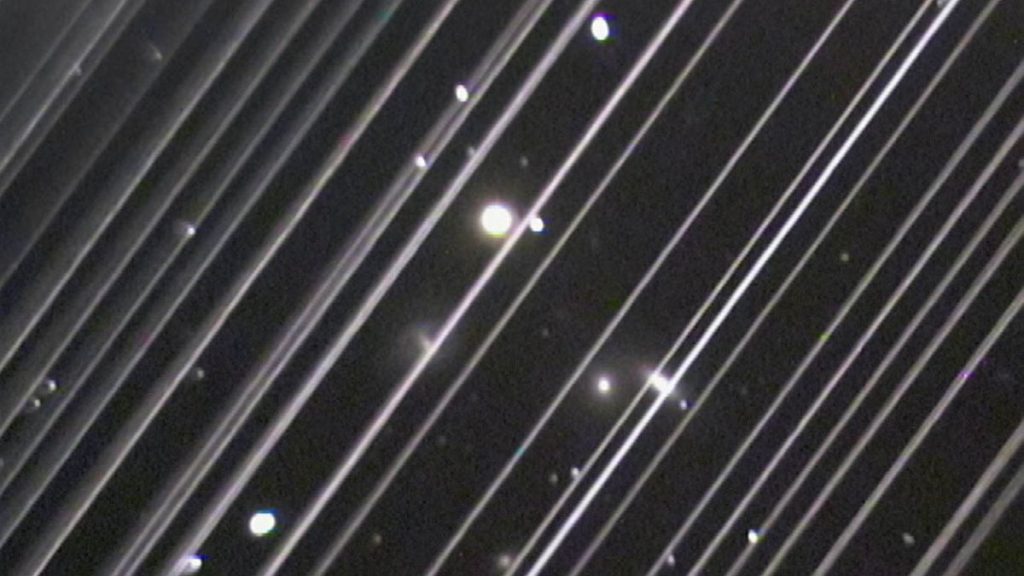SpaceX’s new Starlink satellites produce 32 times more radio noise than their predecessors, causing concerns among astronomers about their interference with radio astronomy observations.
Radio astronomy uses supersensitive antennas to detect faint radio signals emitted by stars, black holes and other objects in the universe. Researchers working at the Low Frequency Array (LOFAR) in the Netherlands, one of the world’s most sensitive radio observatories, have now found that SpaceX‘s growing megaconstellation of internet-beaming satellites is blinding their instruments. During a series of observations conducted in July, the researchers found that Starlink satellites crisscrossing the sky above the array appear up to 10 million times brighter than some of the most precious targets of radio astronomy research.
Jessica Dempsey, the director of the Netherlands Institute for Radio Astronomy, which manages LOFAR, said the satellite radio pollution interferes with measurements of distant exoplanets and nascent black holes. It might also obscure the faint radiation coming from the Epoch of Reionization, one of the least-understood periods in the history of the universe, she added.
This epoch began about one billion years after the Big Bang, when stars grew bright enough to turn the atomic hydrogen that initially filled the expanding space into hydrogen ions. The energy emitted by this hydrogen transformation can be detected today in low-frequency radio waves. The signal is so faint it can only be spotted by the most sensitive radio telescopes and can also be easily lost in an unwanted radio hum.
“Detecting this primordial radiation is one of the big challenges in radio astronomy,” said Dempsey. “Unfortunately, these might be the cases which are lost because of the influx of these satellites, if they remain at this level.”
The researchers don’t know what makes the new generation of Starlink satellites — the V2-mini — so radio noisy. The team previously studied unwanted radio emissions from the first generation of Starllink satellites and were taken aback by the excessive noise of the newer spacecraft.
“With the first generation of satellites, [the radiation] was very sporadic. It wasn’t quite as much of an issue,” said Dempsey. “We were very surprised that this next generation is in some cases 1,000 times above what the limits that protect these frequencies around the antennas.”
The LOFAR radio antennas are surrounded by radio quiet zones, which restrict the use of devices emitting low-frequency radio waves between 10 and 240 Mhz. The noise from above, however, is currently not subject to any regulations. With the growing number of Starlink satellites, this interference is quickly becoming ubiquitous. The Starllink constellation currently consists of more than 6,300 active satellites, but SpaceX has plans to launch over 40,000 of the spacecraft eventually. Other operations, including Amazon’s Project Kuiper and the Chinese constellations Qianfan and Guowang, plan to deploy thousands of satellites in the coming years as well.
“Every time these satellites are launched, there’s five years that they’re up there,” Dempsey said. “They [SpaceX] launch 40 satellites a week. So, it’s so vitally important that we work together immediately to make sure that we have some conviction that these satellites are going to be quiet as soon as we can.”
The interference will also affect the Square Kilometer Array Observatory (SKAO), the world’s largest and most sensitive radio telescope, which is currently being constructed on sites in Australia and South Africa. The Australian part of the SKAO, focused on low frequency radio waves, like LOFAR, would especially suffer from the Starlink radio pollution, astronomers said. SKA-Low, which spreads across 19,100 square miles (49,500 square kilometers) of land in remote Western Australia, will have eight times the sensitivity of LOFAR. That means it will be eight times better at studying the ancient universe, but also eight times more vulnerable to unwanted radio noise. The $2.2 billion project is expected to come online at the end of this decade.
SpaceX began launching the second generation V2-mini satellites in February 2023, according to Gunter’s Space Page. The new satellites are twice as large compared to the earlier generation, featuring more powerful electronics and antennas to provide better connectivity.
“Humanity is clearly approaching an inflection point where we need to take action to preserve our sky as a window to explore the universe from Earth,” Federico Di Vruno, spectrum manager at SKAO, said in a statement. “Satellite companies are not interested in producing this unintended radiation, so minimizing it should also be a priority in their sustainable space policies. Starlink is not the only big player, but they have a chance to set the standard here.”
The new study was published in the journal Astronomy & Astrophysics on Wednesday (Sept. 18).

